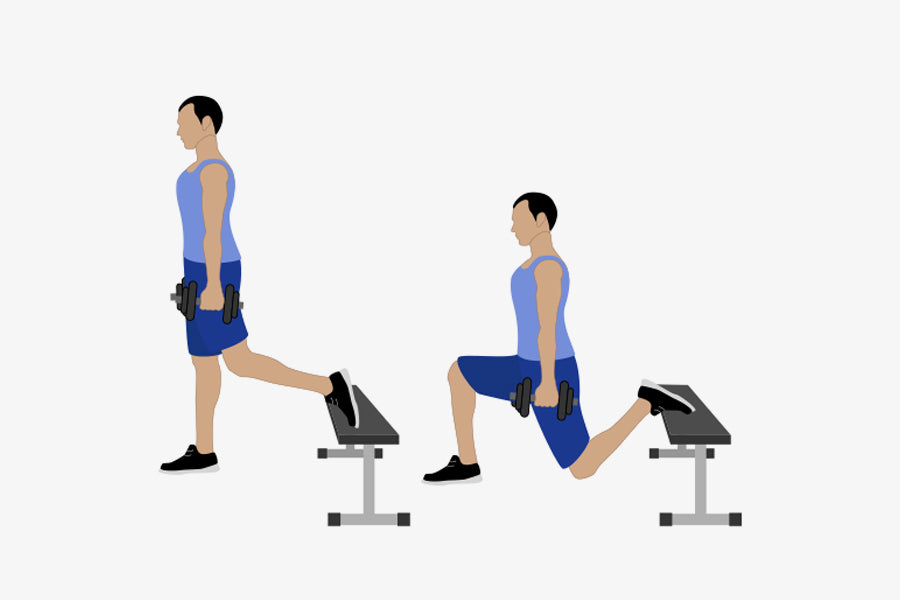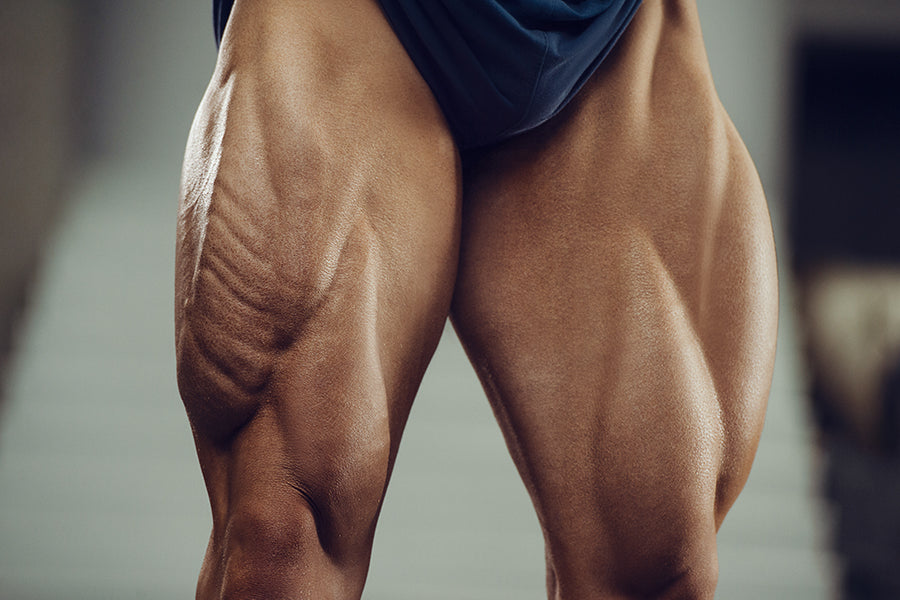Struggling with weak or underdeveloped legs despite consistent workouts? Quad strength is often overlooked, yet it’s key to powering your entire lower body.
Many lifters feel stuck doing the same basic moves without seeing real definition or growth. This can be frustrating, especially when your legs feel like they’re lagging behind.
Your quads deserve targeted attention with exercises that actually work. Strong, sculpted thighs don’t just happen, they’re built with intentional movement and the right tools.
Even better? Most of these quad exercises can be done with minimal equipment! An adjustable dumbbell set is all you need to challenge your legs at home or in the gym.
The 10 Best Quad Exercises
Toned and muscular legs are more than just visually impressive. They reflect real lower-body strength, stability, and athletic potential.
Strong quads support your knees, improve your posture, and reduce the risk of injury during both workouts and daily movement. They’re also key to unlocking better performance in everything from squats to sprints.
If your current routine isn't giving your legs the attention they need, this list will help you change that. These 10 quad exercises are designed to build strength, boost definition, and support overall functional fitness.
1. Bulgarian Split Squat

The Bulgarian split squat is a powerful single-leg movement where your back foot rests on a bench, forcing the front leg to handle most of the load. This setup isolates the working leg and builds lower-body strength with minimal equipment.
Because it shifts most of the tension to the front leg, the quads are heavily engaged throughout the movement, especially during the descent and push-off. It’s an ideal choice for targeting quad growth, enhancing stability, and correcting muscle imbalances.
How to Perform Bulgarian Split Squat
- Stand a few feet in front of a bench.
- Place your back foot on the bench, top side down.
- Keep your front foot flat and chest upright.
- Lower until your front thigh is parallel to the floor.
- Push through the front heel to rise back up.
- Switch legs after completing all reps.
Related Article: Outer Thigh Muscle Anatomy: 6 Best Exercises to Target Your Outer Thighs
2. Tempoed Eccentric Squat

This squat variation slows down the lowering phase of the movement, creating more time under tension for your quads. Controlling the descent for several seconds forces your muscles to work harder, increasing strength and stability.
It’s especially helpful for developing quad control, reinforcing proper squat mechanics, and building deeper muscle engagement. The added focus on form and tension makes it ideal for both strength and hypertrophy training.
How to Perform Tempoed Eccentric Squat
- Set a barbell on a squat rack at shoulder height.
- Position it across your upper back and step out carefully.
- Stand with feet shoulder-width apart and brace your core.
- Lower slowly for 5 seconds into a deep squat.
- Push up quickly to return to the start.
- Repeat while maintaining full control on each descent.
3. Goblet Squat

The goblet squat is a beginner-friendly squat variation performed by holding a kettlebell or dumbbell close to your chest. It builds foundational strength in your quads, glutes, and core while promoting upright posture and balance.
This movement is especially effective for isolating the quads by encouraging deeper range and upright positioning. It’s a great option for those looking to strengthen their thighs without needing a barbell setup.
How to Perform Goblet Squat
- Stand with feet slightly wider than hip-width, toes pointed out.
- Hold a kettlebell at chest height, elbows tucked in.
- Brace your core and keep your chest upright.
- Lower into a squat, keeping the kettlebell close to your body.
- Drop hips below parallel while keeping heels grounded.
- Push through your heels to return to standing.
4. Forward Lunge

The forward lunge is a classic lower-body movement that targets each leg individually to build balance and coordination. It activates multiple muscle groups, but the front leg takes most of the load, which makes it especially effective for quad development.
The deep bend in the front knee places continuous tension on the quads throughout the movement. It also helps strengthen stabilizers and improve single-leg control.
How to Perform Forward Lunge
- Stand tall holding dumbbells at your sides.
- Step forward with your right leg and bend both knees.
- Keep your front thigh parallel to the floor.
- Push off your front foot to return to standing.
- Repeat on the left leg and alternate reps.
5. Step-Up

The step-up builds quad strength by lifting your full body weight onto an elevated surface using one leg at a time. This movement closely mimics real-life actions like climbing stairs and improves functional lower-body strength.
It places heavy demand on the leading leg, forcing the quads to work hard during both the lift and the lowering phase. Step-ups are also useful for building symmetry and stability.
How to Perform Step-Up
- Stand in front of a box or bench.
- Hold dumbbells at your shoulders or sides.
- Step up with your right foot and straighten your leg.
- Bring your left foot up to meet it.
- Step down and repeat with the other leg.
6. Jump Squat

The jump squat is a dynamic, explosive movement that combines lower-body power with cardio intensity. It primarily targets the quads while also engaging the glutes and hamstrings.
By launching upward from a deep squat, your quads experience fast, repeated force that builds strength and muscle responsiveness. It’s ideal for athletes or anyone looking to improve leg speed and endurance.
How to Perform Jump Squat
- Stand with feet shoulder-width apart.
- Lower into a deep squat position.
- Jump straight up using your legs.
- Land softly and return to a squat.
- Repeat with steady rhythm and control.
7. Kneeling Leg Extension

This bodyweight exercise isolates the quads by shifting the workload entirely to the front of the thighs. It challenges the quads to lift and control the body without assistance from other major muscles.
It is especially effective for building mind-muscle connection and improving muscle definition in the quadriceps. No equipment is needed, which makes it easy to add to any routine.
How to Perform Kneeling Leg Extension
- Kneel with knees hip-width apart.
- Keep your core tight and arms forward for balance.
- Lean back slowly without arching your back.
- Stop before losing control or straining.
- Use your quads to return to upright.
8. Lateral Lunge

Lateral lunges are a variation of the traditional lunge that targets the quads, hamstrings, and adductors through a side-to-side movement pattern. This exercise places more emphasis on balance and coordination, engaging stabilizing muscles that are often underused.
By stepping laterally, your quads are forced to decelerate and control the descent, which builds strength and control in the frontal plane. It’s also easier on the lower back than barbell squats and helps improve hip mobility and leg alignment.
How to Perform Lateral Lunge
- Stand upright with feet hip-width apart.
- Step your left foot out wide to the side.
- Shift your weight into your left heel as you lower down.
- Keep your right leg extended with toes up.
- Push off the left foot to return to start.
9. Walking Lunge

Walking lunges add movement to a standard lunge, requiring balance, coordination, and muscular endurance. The constant forward motion challenges your ability to stabilize while keeping tension on your quads throughout each step.
This variation builds functional leg strength and enhances quad activation with every stride. It’s a great choice for improving balance, posture, and overall lower-body conditioning.
How to Perform Walking Lunge
- Stand tall with feet hip-width apart.
- Keep your torso upright and core engaged.
- Step forward with your right leg into a lunge.
- Lower until both knees are bent at 90 degrees.
- Push through the front heel and step into the next lunge.
- Continue alternating legs with each step.
10. Box Jump

Box jumps are an explosive plyometric movement that builds lower-body power and athletic performance. They engage the glutes, hamstrings, and calves, but the quadriceps play a leading role in generating upward force.
This movement challenges your ability to produce speed and strength from the ground up, making it ideal for quad development. It also improves coordination, balance, and reaction time with every jump.
How to Perform Box Jump
- Stand facing a box, feet hip-width apart and about six inches away.
- Bend your knees and hips slightly, swinging your arms back.
- Explode upward, driving through your feet and swinging your arms forward.
- Land softly on the box with bent knees and hips.
- Stand tall at the top and check foot position.
- Step down carefully and reset for the next rep.
Related Article: Five At-Home Exercises for Athletes to Build Stronger Legs
FAQs
1. How often should I train my quads for optimal growth?
Training your quads 2 to 3 times per week is ideal for most people. Be sure to allow at least 48 hours between intense sessions to support proper recovery and muscle growth.
2. Can I build strong quads without using heavy weights?
Yes, bodyweight and moderate resistance exercises like goblet squats, lunges, and jump squats can effectively build quad strength when performed with proper form, tempo, and volume.
3. What is the best quad exercise for beginners?
Goblet squats are highly recommended for beginners because they teach correct squat mechanics, improve posture, and engage the quads without overloading the spine.
4. How do I know if my quads are weak?
Common signs include knee pain during squats or stair climbing, difficulty stabilizing during single-leg movements, and fatigue in your thighs before other leg muscles when exercising.
5. Should I feel soreness in my quads after every workout?
Occasional soreness is normal, especially after introducing new exercises or increasing intensity. However, consistent soreness may indicate poor recovery or overtraining.
6. Do quad exercises also work other parts of the legs?
Yes, while these exercises emphasize the quads, they often engage supporting muscles like the glutes, hamstrings, calves, and core for stability and balance.
The Bottom Line
Strong quads are more than just a visual achievement, they’re the driving force behind explosive lifts, stable joints, and confident movement. Whether you're chasing strength, endurance, or definition, these ten exercises give you the tools to make real progress.
Now it’s your turn to take action. Pick a few movements from this list, stay consistent, and challenge your limits one rep at a time. Your legs will not only look better, they’ll perform better in every part of your life.
Start today, stay disciplined, and let your quads do the talking.














